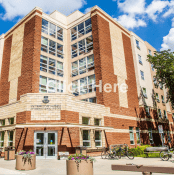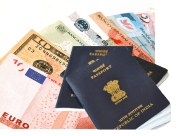Study in Canada
About CANADA
Canada is a country in North America. Its ten provinces and three territories extend from the Atlantic Ocean to the Pacific Ocean and northward into the Arctic Ocean, covering over 9.98 million square kilometers. Making it the world’s second-largest country by total area. Canada’s capital is Ottawa, and its three largest metropolitan areas are Toronto, Montreal, and Vancouver. A highly developed country, Canada has the 24th highest nominal per capita income globally and the sixteenth-highest ranking on the Human Development Index. Its advanced economy is the eighth-largest in the world,
Canada ranks 39th by population. Canada’s largest population centres are Toronto, Montreal, Vancouver, Calgary, Edmonton and Ottawa, The current population of Canada is 38,530,969 as of Tuesday, November 22, 2022, based on World meter elaboration of the latest United Nations data
The coldest place in Canada based on average yearly temperature is Eureka, Nunavut, where the temperature averages at −19.7 °C or −3 °F for the year
The hottest places in Canada are in the southern prairies and the southern interior of British Columbia. Heat waves of over 40 °C (104 °F).
Total 17 Nobel Prize from Canadian Universities.
Why Study in Canada?
•World-class Education
•Affordable Course Fees and Living Cost
•Work Opportunity During and Post Study
•Coveted Jobs and Lucrative Salaries
•Abundant Research Opportunities
•Scholarship
•Immigration Benefits
•Safety and Peace
•Welcoming People and Cultural Diversity
•Vibrant Cities, Scenic Beauty, and Quality Life
Universities in Top 100 Rankings-
University of Toronto.
University of British Columbia
McGill University.
INTAKES: JAN / MAY/ SEPTEMBER.
POPULAR COURSES:
Global business Management.
Project Management.
Information Technology.
Bio science.
Engineering.
Public Health.
Interactive Media Design.
Agribusiness.
Human Resources Management.
Construction Management.
Accounting & Finance.
Procedure (Step by steps):
1. Document Submission.
2. University and College Preference.
3. Apply to the university and college.
4. Pay Application Fee
5. Received Offer letter from college and University.
6. Tuition fee payment.
7. GIC Payment.
8. Medical by Panel Doctor
9. PCC (If required)
10. Visa Application
Additional Information-
Popular Tourist Destination:
Flyover Canada in Vancouver.
Calgary Tower.
La Grande Roué de Montréal.
Plaza Premium Lounge at Toronto Pearson.
Niagara Falls.
Transportation in Canada:
Domestic Airlines: Flying is the most efficient and fastest way to travel long distances across North America. Canada’s two largest air carriers, Air Canada and WestJet, serve most Canadian cities. Regional carriers include Porter Airlines, which flies out of the Toronto Island Airport to Ottawa, Montreal, Halifax, and a number of US cities. All Canadian carriers provide online booking services and most offer a range of prices for one-way flights. •Air Canada: https://www.aircanada.com •West Jet: https://www.westiet.com •Porter: https://www.flyporter.com
Rail Travel: VIA Rail Canada provides passenger rail service in Canada. This includes VIA’s twice-weekly service between Montreal and Halifax and transport between Toronto and Vancouver. Rail travel is most popular on the “Quebec-Windsor corridor,” including Toronto, Montreal, and Ottawa. Amtrak services are also available from Vancouver, Toronto, and Montreal to destinations in the US. •VIA Rail (Canada): https://www.viarail.ca •Rocky Mountaineer Vacations: https://www.rockymountaineer.com
Bus Travel: Bus travel in Canada includes either local transit or long-distance vehicles. Although several bus services have stopped running in the past rew years, were are sull ous services avallable in some places. •MegaBus – Ontario: camegabus.com •Banff Airporter-Calgary-Banff: https://www.baffairporter.com •Pursuit-Rockies: https://www.banffiaspercollection.com •DRL Coach Lines-Newfoundland: www..dr-Ir.com •Orléans Express-Quebec: https://www.orleansexpress.com *Quick Shuttle-Vancouver-Seattle: https://www.quickcoach.com
Ferries
BC Ferries: https://www.bcferries.com •Victoria Clipper-Victoria-Seattle: https://www.clippervacations.com/ •Alaska Marine Highway-Prince Rupert-Alaska: https://www.akferry.org •Marine Atlantic-Nova Scotia-Newfoundland: https://www.marine-atlantic.ca •Northumberland Ferries: https://www.nfl-bay.com
INSURANCE:
Virtually all Canadian education institutions have medical insurance plans available to international students. Students should contact the institution they plan to attend for information about health insurance coverage. Sometimes institutions will require that international students purchase medical insurance; in any case, it is a very good idea to have it and ensure that it will be accepted in the province where the student will study. The cost of a medical insurance plan will be far less than a circumstance in which a student gets injured or sick and has no coverage. Most institutions will help international students decide on health insurance during orientation week (the week devoted to helping new students get ready for studies at the school).
Regardless of whether or not they plan to purchase coverage from a Canadian institution, students should purchase travel health insurance. Ideally, this should be for the time they leave for Canada to the first week after arrival. Some major credit cards may have travel health insurance included as part of the services offered by the card, so students should check the insurance they already have. If they need to purchase more, a travel agent can help advise on which options are available to them.
SAFETY:
The Global Peace Index regularly ranks Canada as one of the safest countries in the world. Despite this, international students should follow the same common-sense safety precautions in Canada as they would anywhere in the world.
Working In Canada:
If students are eligible to work in Canada (please
see www.cic.gc.ca/english/study/work.asp for information on work permits), they will need to have a Social Insurance Number (SIN) and they should be aware of their rights while employed in Canada.
Social Insurance Number (SIN)
International students will require a Social Insurance Number (SIN) to work in Canada. They can pick up a SIN application form at the airport as soon as they arrive or afterward at any Canada Post outlet or Service Canada office. For more information, please visit www.servicecanada.gc.ca
Workers’ Rights and Benefits
Federal and provincial laws protect workers and employers by setting minimum wage levels, health and safety standards, and hours of work. They provide for maternity leave, and annual paid vacation. There are also laws to protect workers from discrimination, including protection from unfair treatment by employers based on race, religion, nationality, gender, age, sexual orientation or disability.
A student’s employer will legally deduct money from their pay cheque for income tax, the Canada Pension Plan, Employment Insurance and, where applicable, taxable benefits, and union dues.
Canada’s major banks are:
•Royal Bank of Canada.
•Scotiabank.
•Canadian Imperial Bank of Commerce.
•Bank of Montréal.
•TD Canada Trust.
•HSBC Canada.
•National Bank of Canada.
Tipping and Taxes
In Canada, it is customary to tip service providers such as bartenders, waiters, hairdressers, concierges, and cab drivers. A tip is a sign of appreciation for service provided and the amount given should reflect that. You are generally expected to tip 15 to 20% of the total amount of your bill, and unlike in many countries, the tip is not usually included in the bill amount.
A national tax of 5% is added to the price of most goods. This tax, known as the Goods and Services Tax (GST), is not included in the price of an item, but rather is added on at the time of payment.
Some provinces use a Harmonized Sales Tax (HST), which combines a provincial sales tax with the ST. The combination of taxes per province at the point of sale is the following:
•New Brunswick: 15%
•Newfoundland and Labrador: 15%
•Nova Scotia: 15%
•Ontario: 13%
•Prince Edward Island: 15%
Some provinces have yet to adopt the HST and still charge a provincial sales tax and the GST separately, but they are both added at the time of payment. The provincial sales tax for these provinces is the following:
•British Columbia: 7%, for a total of 12% tax at point of sale
•Manitoba: 8%, for a total of 13%
•Quebec: 9.98%, for a total of 14.98%
•Saskatchewan: 6%, for a total of 11%
Note: Alberta, Nunavut, Yukon, and the Northwest Territories do not have a provincial sales tax.
Whichever Canadian province you are in, it is important to note that tax is added at the time of payment in Canada.
Therefore, the actual price you pay to the cashier will be five to 15% higher than what is listed on a price tag, or in an advertisement.
General Tips for International Students
International students should:
•Not work for any employer without signing a contract. Without this proof of employment, their rights may be severely reduced if anything goes wrong.
•Always ask for pay stubs (a record of hours worked as well as taxes deducted and net pay) and keep them together in a safe place.
•Check their pay stubs to ensure that their employer is deducting the necessary taxes from their pay. Not deducting taxes is illegal.
•Not accept any “under the table” jobs where they are paid in cash and not registered as official employees. These types of jobs are illegal and can result in stiff penalties.
•Ensure that they are paid at least the minimum wage in the province where they reside.
Finding Employment
Students can find out about employment opportunities by consulting their institution’s careers centre, their municipal government, newspapers, and online job banks. They can also use:
www.jobbank.gc.ca
www.youth.gc.ca
www.monster.ca
www.workopolis.com
www.indeed.ca
Job Bank: https://www.jobbank.gc.ca
Youth in Canada – Canada.ca: https://www.youth.gc.ca
Visa Fund & requirements






